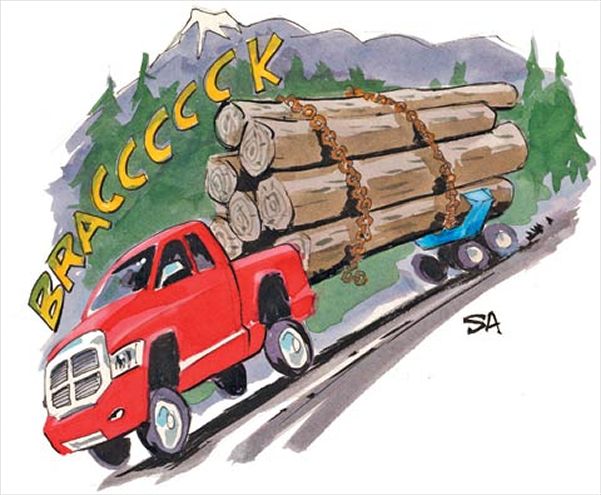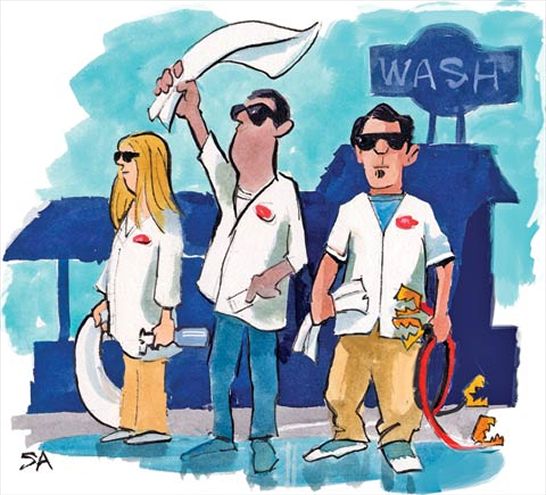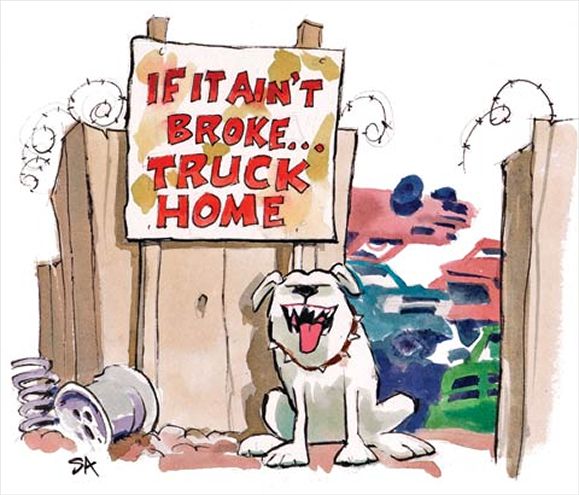Ram Losing its CoolQ: I have a 2000 Dodge Ram with the 5.9-liter V-8. The air-conditioner started blowing warm air, so I added coolant. The A/C worked for about two months and then ran out of coolant again. I can tell when it gets low, because the compressor starts to kick on and off. Recently, I added a can of coolant with dye in it and found no sign of a leak. What else can I do to check for leaks?

| expert Advice illustration By Steve Austin
A: Coolant is a mixture of antifreeze and water in the radiator. R134A refrigerant is what's leaking out of your air-conditioning system. Assuming the proper refrigerant dye was installed correctly, you should be scanning all A/C components, hoses, lines, and connections with the appropriate ultraviolet lamp. A leak will show up as a bright-yellow/green glow of the dye. There are also electronic refrigerant leak detectors, which can help pinpoint leaks more quickly, but not necessarily as accurately. One leak that can be difficult to trace is from the evaporator core, inside the cab within the dash. Crawl under the truck and be sure to shine the UV lamp inside the evaporator's condensation drain hole or tube. It may take some time and mileage, but if the evaporator is leaking the dye will slowly drip out of the drain along with the refrigerant oil. Evaporator replacement on a Ram is a considerable job, requiring more than five hours labor, plus parts and a refrigerant recharge.
Out Go the LightsQ: My 2000 4WD Z71 Chevrolet Silverado just hit 60,000 miles and selective lights on my dashboard have gone out. For instance, a few of the radio-station presets (1, 2, and 3) and the radio mode (AM/FM/CD) don't light up. Is this something as simple as a fuse or is it an electrical issue with the entire dash?
A: The radio display is activated by the ignition. The illumination lights come on with the headlamp switch and are then controlled by the instrument-panel dimmer control. Radio illumination is a string of bulbs on an internal circuit within the radio. If there were a problem with an external voltage or ground source, all the lights would be out. Just a few switches going dark means the applicable bulbs within the radio have burned out and need to be replaced. These bulbs aren't considered serviceable parts. The radio should be removed and sent to an automotive-electronics contractor for repair or replacement with an exchange unit.
Exhaust or Jake BrakeQ: You recently updated a previous story regarding the catastrophic mechanical failure of a 6.6-liter Duramax diesel engine in a 2003 Chevy truck. One sentence caught my eye: "An exhaust brake, used to amplify engine braking on a diesel engine, does have the potential for producing excessive backpressure, which can cause valve float and lead to valve-to-piston contact." A few months ago, I purchased a new 2006 Ram 3500 SLT 4x4 with the Cummins ISB 5.9-liter I-6 coupled to Dodge's six-speed manual transmission. As part of the negotiations, I ordered it with the Jacobs exhaust brake as a Mopar dealer-installed option. I chose the Jake brake over other exhaust brakes because it comes with a comprehensive three-year/100,000-mile warranty. I'm pleased with the exhaust brake's performance, but after reading your article, I'm concerned about something like that happening to my new truck. Since Dodge, Cummins, and Jacobs collaborated on this exhaust brake, I'm hoping the risk of such damage is close to negligible compared with other manufacturers' units. Is that the case? Do you have any advice for usage of the Jacobs brake (specifically regarding to the general directions from Jacobs to keep the rpm as high as possible without exceeding 3200)?

| expert Advice illustration By Steve Austin
A: Exhaust brakes have the potential to produce excessive backpressure, which can overpower exhaust-valve spring tension, cause valve float, and eventual valve-to-piston contact. But engine damage from a quality exhaust brake is by no means a common occurrence, especially when operated as directed by the manufacturer.
Our previous story involved a truck manufacturer implicating an aftermarket exhaust brake as the cause of engine damage in denial of a warranty claim, but there was no evidence available to support the allegation. An engineer's report, in conjunction with owner compensation from the truck manufacturer, supported the innocence of the exhaust brake in question.
Thumbs up on choosing the Jacobs exhaust brake, approved by Cummins and Dodge as a dealer-installed option. This should, if used correctly, eliminate the possibility of engine damage or discrepancies with related powertrain warranty claims. The magic number is 3200 rpm; let's call it the Jacobs redline. Exhaust brakes do their best work at higher engine speeds, but exceeding the 3200-rpm threshold during deceleration may produce dangerously high levels of backpressure, similar to how accelerating past your truck's redline exceeds the engine's designed capabilities, and therefore increases the risk of engine damage. Most exhaust brakes don't allow the butterfly to close all the way, or they incorporate a calibrated orifice to avoid a complete blockage of the exhaust system. This prevents backpressure from surpassing the engine's limitations--even if the exhaust brake fails and is stuck closed. But again, engine safety goes out the window if you blow by that Jacobs redline. An exhaust brake can be a valuable asset and a reliable component for commercial and light-duty diesel-truck applications.
Converting to EthanolQ: I have a 2002 Dodge Dakota with the 4.7-liter V-8. The engine has only 38,000 miles on it, so it's barely broken in. Dodge is making a 4.7-liter V-8 for some of its vehicles, which can run on ethanol. Is there a conversion for my 4.7-liter to make it ethanol compatible?
A: Ethanol is an alcohol-based alternative fuel typically derived from renewable sources such as corn, barley, or wheat. E85 is a mix of 85 percent ethanol and 15 percent gasoline for use in cars and trucks factory-equipped with an FFV (flexible-fuel vehicle) option and available at a growing number of pumps in various regions across the U.S. E85 produces lower amounts of certain harmful emissions and also can reduce the amount of imported petroleum-based fuel burned. But a gallon of E85, while comparably priced with regular unleaded, generates less energy than a gallon of straight gas, resulting in a shorter range and fewer mpg. Flexible means just that--FFVs also can run on standard grades of gasoline at the owner's discretion. Factory-installed FFV packages include upgraded fuel pumps, lines, tanks, and additional fuel-system components modified to tolerate the corrosive properties of alcohol-based fuels. Larger injectors are installed to disburse the necessary higher volume of fuel. Most systems require a fuel sensor to determine ethanol content and PCM calibration to adjust the air/fuel ratio. Many FFV owners are unaware of their vehicle's fuel-flex capacity and run solely on gasoline. There's usually an FFV notice on the fuel-tank filler door, or a dealership can determine E85 compatibility by the VIN. For 2002, Dodge produced only the 3.3-liter V-6 FFV Caravan for retail sale, so your Dakota isn't FFV-equipped. Currently no EPA-approved FFV conversion kits are available, partially due to the minimal expense of the factory option, and perhaps the higher focus on additional alternative energy sources, as seen by the growing production of hybrid-electric vehicles and aggressive early development in hydrogen fuel-cell technology.

| expert Advice illustration By Steve Austin
Clean-Car GremlinsQ: My 2000 Oldsmobile Bravada wouldn't start after I had it washed. The car-wash attendant jumpstarted it, and it lit right up. Soon after that, the air-conditioner quit working. When the controls are turned on, it blows hot air. I traced the problem to something under the hood and changed out fuse #10, in case it had blown. I know there's a relay for the A/C and the compressor's cold, but I'm not sure what to do at this point. If the unit's low on Freon, would there be any warnings before the unit blows hot air?
A: I can't see the car wash or jumpstart being a relevant factor. Needing a boost is a sign of a bad battery or a charging-system problem and shouldn't have an effect on air-conditioner operation. That the compressor is cold and the air coming out of the A/C vents is hot suggests a temperature-control fault in the system. The temperature knob on the manual air-conditioning control panel powers an electric temperature-control motor. The motor positions a valve that directs air through the air-conditioning evaporator and/or the heater core, therefore managing air temperature out of the ducts. There may be a problem with the controller, the temperature motor, the valve hanging up, the electronic climate-control module (if equipped), or there may be a wiring problem. But the first thing to check is the temperature-control knob itself. It's plastic and has a habit of cracking right where it attaches to the switch in the control panel. If it cracked while turned all the way to hot, you can turn the knob back to cold without actually moving the switch, therefore it would remain in hot mode. Pull off the knob and inspect for cracks. You shouldn't have to replace the entire control assembly to get a new knob. If it checks out okay, a qualified technician can accurately pinpoint the problem.
Shifting Your PerspectiveQ: I own a 1999 Dodge Ram 1500-series pickup with the 5.2-liter V-8 with 84,000 miles on it. I recently noticed the transmission is acting up. At 45 to 55 mph, when I let off the gas to slow down, the transmission will downshift to the last gear it was in and stay in that gear for a long time before finally shifting out. I drive with the transmission in overdrive. If I turn off overdrive and turn it on again, it won't shift out of gear.

| expert Advice illustration By Steve Austin
A: Going 84,000 miles without servicing the transmission could be a contributing factor. I pulled up Dodge Technical Service Bulletin 18-006-02 REV.C. This one pertains to several performance issues including a "no upshift into overdrive (fourth gear)" condition following a downshift into third. The correction entails a reprogramming of the powertrain control module. Also, TSB 21-04-00 deals with excessive governor pressure due to a new transmission valve-body-machining process that went into effect in January 1998. The excessive hydraulic pressure may trigger a trouble code and illuminate the malfunction indicator lamp on the instrument panel and then put the transmission into a default "limp" mode, which keeps it in third gear until the engine's shut off and restarted. Again, PCM reprogramming may correct the problem. Get the truck to a Dodge service department or a transmission shop that performs sublet work for a Dodge dealership. TT
Sticky Spark PlugsQ: I'm having problems changing the spark plugs in my 5.3-liter-powered 2002 Chevy Silverado 1500 4x4. I can't get the plug wires off. Is there a trick to it?
A: There are specialty tools available that'll help you remove plug wires, but that shouldn't be necessary when working on a 5.3-liter V-8. General Motors' service procedure recommends first twisting the plug-wire boot a half-turn and then pulling the boot off the spark plug by hand. The half-turn should break the adhesion between the rubber boot and the plug, making it easy to remove while preventing damage to the wire. Only pull on the boot--never pull on the plug wire itself, as that's a sure-fire way to rip the wire out of the terminal, which connects to the top of the spark plug. Excessive corrosion at the plug may cause plug-wire removal to get more difficult and could make wire damage unavoidable. Once the wires are removed, back the spark plugs out one or two turns and use compressed air to clear the surrounding area. This prevents dirt and grime from falling into the cylinder bore once the plugs come all the way out. Keep in mind that GM released new spark plugs for the 5.3-liter. The new plugs use Iridium instead of a platinum tip, with an updated plug gap of 0.04-inch. The gap should be set from the factory, so double-check the clearance but don't attempt adjustment, as plug damage may occur.
Stalling FordQ: My 1997 F-250 stalls when I put it in reverse. Sometimes it'll also stall when the truck is stopped. The check-engine light isn't on. Do you know what could be causing this?
A: I don't know what engine's under your truck's hood, and a number of engine-related faults can cause stalling similar to what you've described. But a few 1996-1998 Ford trucks equipped with the E40D automatic transmission have produced stalling during engagement. The transmission-fluid filter assembly may become loose or detached. This can be confirmed by removing the transmission-fluid pan. If the filter drops with the pan, or isn't firmly seated in the transmission pump bore, an updated fluid filter assembly should correct the problem. Check with Ford parts for the applicable filter assembly and instructions for your particular F-250. If the filter's secure, and/or previously replaced with the updated part, have the truck's powertrain performance evaluated by a qualified technician.
How To Reach AlexIf you have a technical question regarding your pickup, SUV, or van, feel free to contact Alex, a master technician with the National Institute for Automotive Service Excellence. Send a letter to him in care of Truck Trend Garage, 831 S. Douglas Street, El Segundo, CA 90245, or e-mail us at trucktrend@sourceinterlink.com. Please include the VIN with your question. Due to the volume of questions received every month, we cannot guarantee that everyone's question will be personally answered or will appear in the magazine.
Can't wait for help with a problem you're having with your Truck or SUV? Ask the expert we trust here at Truck Trend Garage--visit Alex Steele at www.RealWorldAutomotive.com.
 | expert Advice illustration By Steve Austin
A: Coolant is a mixture of antifreeze and water in the radiator. R134A refrigerant is what's leaking out of your air-conditioning system. Assuming the proper refrigerant dye was installed correctly, you should be scanning all A/C components, hoses, lines, and connections with the appropriate ultraviolet lamp. A leak will show up as a bright-yellow/green glow of the dye. There are also electronic refrigerant leak detectors, which can help pinpoint leaks more quickly, but not necessarily as accurately. One leak that can be difficult to trace is from the evaporator core, inside the cab within the dash. Crawl under the truck and be sure to shine the UV lamp inside the evaporator's condensation drain hole or tube. It may take some time and mileage, but if the evaporator is leaking the dye will slowly drip out of the drain along with the refrigerant oil. Evaporator replacement on a Ram is a considerable job, requiring more than five hours labor, plus parts and a refrigerant recharge.
Out Go the Lights
| expert Advice illustration By Steve Austin
A: Coolant is a mixture of antifreeze and water in the radiator. R134A refrigerant is what's leaking out of your air-conditioning system. Assuming the proper refrigerant dye was installed correctly, you should be scanning all A/C components, hoses, lines, and connections with the appropriate ultraviolet lamp. A leak will show up as a bright-yellow/green glow of the dye. There are also electronic refrigerant leak detectors, which can help pinpoint leaks more quickly, but not necessarily as accurately. One leak that can be difficult to trace is from the evaporator core, inside the cab within the dash. Crawl under the truck and be sure to shine the UV lamp inside the evaporator's condensation drain hole or tube. It may take some time and mileage, but if the evaporator is leaking the dye will slowly drip out of the drain along with the refrigerant oil. Evaporator replacement on a Ram is a considerable job, requiring more than five hours labor, plus parts and a refrigerant recharge.
Out Go the Lights | expert Advice illustration By Steve Austin
A: Exhaust brakes have the potential to produce excessive backpressure, which can overpower exhaust-valve spring tension, cause valve float, and eventual valve-to-piston contact. But engine damage from a quality exhaust brake is by no means a common occurrence, especially when operated as directed by the manufacturer.
Our previous story involved a truck manufacturer implicating an aftermarket exhaust brake as the cause of engine damage in denial of a warranty claim, but there was no evidence available to support the allegation. An engineer's report, in conjunction with owner compensation from the truck manufacturer, supported the innocence of the exhaust brake in question.
Thumbs up on choosing the Jacobs exhaust brake, approved by Cummins and Dodge as a dealer-installed option. This should, if used correctly, eliminate the possibility of engine damage or discrepancies with related powertrain warranty claims. The magic number is 3200 rpm; let's call it the Jacobs redline. Exhaust brakes do their best work at higher engine speeds, but exceeding the 3200-rpm threshold during deceleration may produce dangerously high levels of backpressure, similar to how accelerating past your truck's redline exceeds the engine's designed capabilities, and therefore increases the risk of engine damage. Most exhaust brakes don't allow the butterfly to close all the way, or they incorporate a calibrated orifice to avoid a complete blockage of the exhaust system. This prevents backpressure from surpassing the engine's limitations--even if the exhaust brake fails and is stuck closed. But again, engine safety goes out the window if you blow by that Jacobs redline. An exhaust brake can be a valuable asset and a reliable component for commercial and light-duty diesel-truck applications.
Converting to Ethanol
| expert Advice illustration By Steve Austin
A: Exhaust brakes have the potential to produce excessive backpressure, which can overpower exhaust-valve spring tension, cause valve float, and eventual valve-to-piston contact. But engine damage from a quality exhaust brake is by no means a common occurrence, especially when operated as directed by the manufacturer.
Our previous story involved a truck manufacturer implicating an aftermarket exhaust brake as the cause of engine damage in denial of a warranty claim, but there was no evidence available to support the allegation. An engineer's report, in conjunction with owner compensation from the truck manufacturer, supported the innocence of the exhaust brake in question.
Thumbs up on choosing the Jacobs exhaust brake, approved by Cummins and Dodge as a dealer-installed option. This should, if used correctly, eliminate the possibility of engine damage or discrepancies with related powertrain warranty claims. The magic number is 3200 rpm; let's call it the Jacobs redline. Exhaust brakes do their best work at higher engine speeds, but exceeding the 3200-rpm threshold during deceleration may produce dangerously high levels of backpressure, similar to how accelerating past your truck's redline exceeds the engine's designed capabilities, and therefore increases the risk of engine damage. Most exhaust brakes don't allow the butterfly to close all the way, or they incorporate a calibrated orifice to avoid a complete blockage of the exhaust system. This prevents backpressure from surpassing the engine's limitations--even if the exhaust brake fails and is stuck closed. But again, engine safety goes out the window if you blow by that Jacobs redline. An exhaust brake can be a valuable asset and a reliable component for commercial and light-duty diesel-truck applications.
Converting to Ethanol | expert Advice illustration By Steve Austin
Clean-Car Gremlins
| expert Advice illustration By Steve Austin
Clean-Car Gremlins | expert Advice illustration By Steve Austin
A: Going 84,000 miles without servicing the transmission could be a contributing factor. I pulled up Dodge Technical Service Bulletin 18-006-02 REV.C. This one pertains to several performance issues including a "no upshift into overdrive (fourth gear)" condition following a downshift into third. The correction entails a reprogramming of the powertrain control module. Also, TSB 21-04-00 deals with excessive governor pressure due to a new transmission valve-body-machining process that went into effect in January 1998. The excessive hydraulic pressure may trigger a trouble code and illuminate the malfunction indicator lamp on the instrument panel and then put the transmission into a default "limp" mode, which keeps it in third gear until the engine's shut off and restarted. Again, PCM reprogramming may correct the problem. Get the truck to a Dodge service department or a transmission shop that performs sublet work for a Dodge dealership. TT
Sticky Spark Plugs
| expert Advice illustration By Steve Austin
A: Going 84,000 miles without servicing the transmission could be a contributing factor. I pulled up Dodge Technical Service Bulletin 18-006-02 REV.C. This one pertains to several performance issues including a "no upshift into overdrive (fourth gear)" condition following a downshift into third. The correction entails a reprogramming of the powertrain control module. Also, TSB 21-04-00 deals with excessive governor pressure due to a new transmission valve-body-machining process that went into effect in January 1998. The excessive hydraulic pressure may trigger a trouble code and illuminate the malfunction indicator lamp on the instrument panel and then put the transmission into a default "limp" mode, which keeps it in third gear until the engine's shut off and restarted. Again, PCM reprogramming may correct the problem. Get the truck to a Dodge service department or a transmission shop that performs sublet work for a Dodge dealership. TT
Sticky Spark Plugs